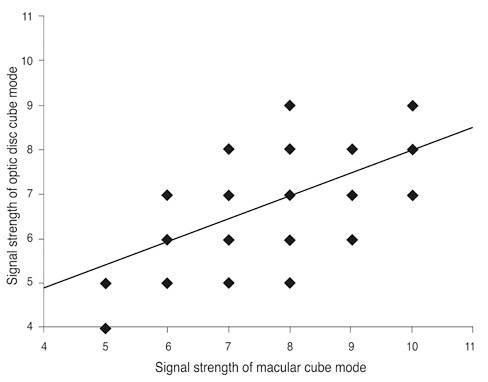Korean J Ophthalmol.
2012 Jun;26(3):169-173. 10.3341/kjo.2012.26.3.169.
Factors Associated with the Signal Strengths Obtained by Spectral Domain Optical Coherence Tomography
- Affiliations
-
- 1Division of Biostatistics, Center for Medical Research and Information, Asan Medical Center, University of Ulsan College of Medicine, Seoul, Korea. sungeye@gmail.com
- 2Department of Ophthalmology, Asan Medical Center, University of Ulsan College of Medicine, Seoul, Korea.
- KMID: 1376121
- DOI: http://doi.org/10.3341/kjo.2012.26.3.169
Abstract
- PURPOSE
The aim of this study was to investigate factors associated with the signal strengths (SS, image quality scores) of optic disc and macular images obtained using Cirrus spectral domain optical coherence tomography (OCT).
METHODS
Ninety-two glaucomatous eyes were imaged using the Cirrus OCT macular and optic disc cube modes after pupil dilation. The influences of patient age, spherical equivalent, cataract presence, and cataract and glaucoma severity (visual field mean deviation), on the SS of images obtained using the two cube modes were compared between patients whose images showed high SS (SS > or =7) and low SS (SS <7).
RESULTS
The signal strength was significantly higher in images obtained using the macular cube compared to the optic disc cube mode (7.8 +/- 1.3 vs. 6.9 +/- 1.1, respectively; p = 0.001). Age and visual acuity of patients differed significantly between the high- and low-SS groups when data acquired using the optic disc (p = 0.027 and 0.012, respectively) and macular cube modes (p = 0.046 and 0.014, respectively) were analyzed. When the optic disc cube mode was employed, the extent of cataracts was significantly related to SS, whereas when the macular cube mode was used, none of the factors analyzed was significantly associated with SS.
CONCLUSIONS
Age, visual acuity, and the extent of cataracts were significantly associated with images of higher SS when the Cirrus OCT optic disc cube mode was employed.
Keyword
MeSH Terms
Figure
Cited by 2 articles
-
Comparison of Ganglion Cell-Inner Plexiform Layer and Retinal Nerve Fiber Layer after Cataract Surgery
Young Soo Han, Pyung Lee, Kyung Hyun Jin
J Korean Ophthalmol Soc. 2015;56(4):485-493. doi: 10.3341/jkos.2015.56.4.485.The Variation of Choroidal Thickness and Refractive Error after Cataract Surgery
Hyun Cheol Roh, Choul Yong Park, Jong-Hyun Oh
J Korean Ophthalmol Soc. 2016;57(6):924-929. doi: 10.3341/jkos.2016.57.6.924.
Reference
-
1. Quigley HA, Katz J, Derick RJ, et al. An evaluation of optic disc and nerve fiber layer examinations in monitoring progression of early glaucoma damage. Ophthalmology. 1992. 99:19–28.2. Sommer A, Katz J, Quigley HA, et al. Clinically detectable nerve fiber atrophy precedes the onset of glaucomatous field loss. Arch Ophthalmol. 1991. 109:77–83.3. Zeyen TG, Caprioli J. Progression of disc and field damage in early glaucoma. Arch Ophthalmol. 1993. 111:62–65.4. Blumenthal EZ, Williams JM, Weinreb RN, et al. Reproducibility of nerve fiber layer thickness measurements by use of optical coherence tomography. Ophthalmology. 2000. 107:2278–2282.5. Schuman JS, Pedut-Kloizman T, Hertzmark E, et al. Reproducibility of nerve fiber layer thickness measurements using optical coherence tomography. Ophthalmology. 1996. 103:1889–1898.6. Blumenthal EZ, Weinreb RN. Assessment of the retinal nerve fiber layer in clinical trials of glaucoma neuroprotection. Surv Ophthalmol. 2001. 45:Suppl 3. S305–S312.7. Smith M, Frost A, Graham CM, Shaw S. Effect of pupillary dilatation on glaucoma assessments using optical coherence tomography. Br J Ophthalmol. 2007. 91:1686–1690.8. Stein DM, Wollstein G, Ishikawa H, et al. Effect of corneal drying on optical coherence tomography. Ophthalmology. 2006. 113:985–991.9. Van Velthoven ME, van der Linden MH, de Smet MD, et al. Influence of cataract on optical coherence tomography image quality and retinal thickness. Br J Ophthalmol. 2006. 90:1259–1262.10. Sung KR, Wollstein G, Schuman JS, et al. Scan quality effect on glaucoma discrimination by glaucoma imaging devices. Br J Ophthalmol. 2009. 93:1580–1584.11. Wu Z, Huang J, Dustin L, Sadda SR. Signal strength is an important determinant of accuracy of nerve fiber layer thickness measurement by optical coherence tomography. J Glaucoma. 2009. 18:213–216.12. Wu Z, Vazeen M, Varma R, et al. Factors associated with variability in retinal nerve fiber layer thickness measurements obtained by optical coherence tomography. Ophthalmology. 2007. 114:1505–1512.13. Menke MN, Dabov S, Knecht P, Sturm V. Reproducibility of retinal thickness measurements in healthy subjects using spectralis optical coherence tomography. Am J Ophthalmol. 2009. 147:467–472.14. Chylack LT Jr, Wolfe JK, Singer DM, et al. The Lens Opacities Classification System III. The Longitudinal Study of Cataract Study Group. Arch Ophthalmol. 1993. 111:831–836.15. Cheung CY, Leung CK, Lin D, et al. Relationship between retinal nerve fiber layer measurement and signal strength in optical coherence tomography. Ophthalmology. 2008. 115:1347–1351. 1351.e1–1351.e2.16. Moreno-Montanes J, Olmo N, Alvarez A, et al. Cirrus high-definition optical coherence tomography compared with Stratus optical coherence tomography in glaucoma diagnosis. Invest Ophthalmol Vis Sci. 2010. 51:335–343.
- Full Text Links
- Actions
-
Cited
- CITED
-
- Close
- Share
- Similar articles
-
- Analysis of Factors Associated with Variability in Measures Obtained by Spectral Domain Optical Coherence Tomography
- A Case of Ocular Toxoplasmosis Imaged with Spectral Domain Optical Coherence Tomography
- Fundus Autofluorescence, Fluorescein Angiography and Spectral Domain Optical Coherence Tomography Findings of Retinal Astrocytic Hamartomas in Tuberous Sclerosis
- Comparison of the Efficacy between Time and Spectral Domain Optical Coherence Tomography for the Identification of Vitreomacular Interface
- Choroidal Thickness at the Outside of Fovea in Diabetic Retinopathy Using Spectral-Domain Optical Coherence Tomography


